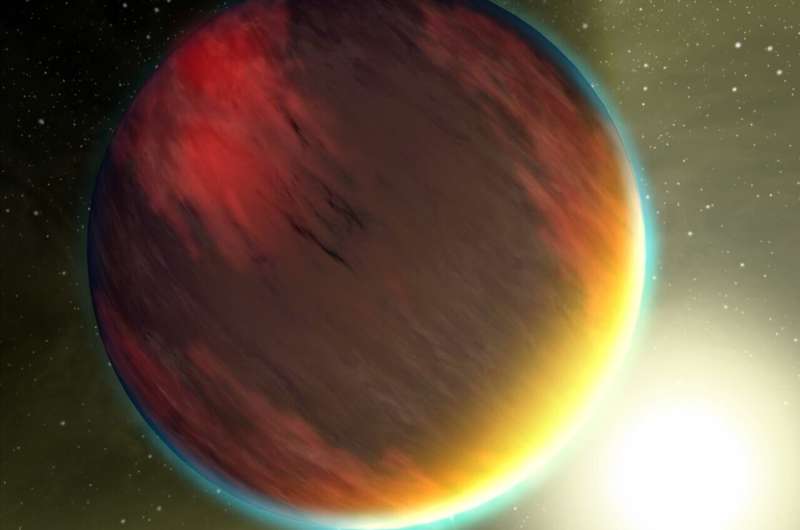Newborn gas planets may be surprisingly flat, says new research

A new planet starts its life in a rotating circle of gas and dust, a cradle known as a protostellar disk. My colleagues and I have used computer simulations to show that newborn gas planets in these disks are likely to have surprisingly flattened shapes. This finding, published in Astronomy and Astrophysics Letters, could add to our picture of exactly how planets form.
Observing protoplanets that have just formed and are still within their protostellar disks is extremely difficult. Until now only three such young protoplanets have been observed, with two of them in the same system, PDS 70.
We need to find systems that are young, and close enough for our telescopes to be able to detect the dim light from the planet itself and distinguish it from that of the disk. The whole process of planetary formation lasts only a few million years which is nothing more than a blink of an eye in astrophysical scales. This means we need to have luck to catch them in the act of forming.
Our research group performed computer simulations to determine the properties of gaseous protoplanets under a variety of thermal conditions in the planets' cradles.
The simulations have enough resolution to be able to follow the evolution of a protoplanet in the disk from an early stage, when it is just a mere condensation within the disk. Such simulations are computationally demanding and were run on DiRAC, the UK's astrophysics supercomputing facility.
Typically, multiple planets form within a disk. The study found that protoplanets have a shape known as oblate spheroids, like Smarties or M&M's, rather than being spherical. They grow by drawing gas predominantly through their poles rather than their equators.
Technically, the planets in our solar system are also oblate spheroids but their flattening is small. Saturn has a flattening of 10%, Jupiter 6%, whereas Earth a mere 0.3%.
In comparison, the typical flattening of protoplanets is 90%. Such a flattening will affect the observed properties of protoplanets, and it needs to be taken into account when interpreting observations.
How planets start off
The most widely accepted theory for planet formation is that of "core accretion". According to this model, tiny dust particles smaller than sand collide with each other, group together and progressively grow into larger and larger bodies. This is effectively what happens to the dust under your bed when it isn't cleaned.
Once a core of dust with enough massive forms, it draws gas from the disk to form a gas giant planet. This bottom-to-top approach would take a few million years.
The opposite, top-to-bottom approach, is the theory of disk instability. In this model, the protostellar disks that attend young stars are gravitationally unstable. In other words, they are too heavy to be maintained and so fragment into pieces, which evolve into planets.
The theory of core accretion has been around for a long time and it can explain many aspects of how our solar system formed. However, disk instability can better explain some of the exoplanetary systems we have discovered in recent decades, such as those where a gas giant planet orbits very very far from its host star.
The appeal of this theory is that planet formation happens very fast, within a few thousand years, which is consistent with observations that suggest planets exist in very young disks.
Our study focused on gas giant planets formed via the model of disk instability. They are flattened because they form from the compression of an already flat structure, the protostellar disk, but also because of how they rotate.
No flat Earths
Although these protoplanets overall are very flattened, their cores, which will eventually evolve into gas giant planets as we know them, are less flattened—only by about 20%. This is just twice the flattening of Saturn. With time they are expected to become more spherical.
Rocky planets, like Earth and Mars, cannot form via disk instability. They are thought to form by slowly assembling dust particles to pebbles, rocks, kilometer-sized objects and eventually planets. They are too dense to be significantly flattened even when they are newly born. There is no possibility that Earth was flattened at such a high degree when it as young.
But our study does support a role for disk instability in the case of some worlds in some planetary systems.
We are now moving from the era of exoplanet discoveries to the era of exoplanet characterization. Many new observatories are set to become operational. These will help discover more protoplanets embedded in their disks. Predictions from computer models are also becoming more sophisticated.
The comparison between these theoretical models and observations is bringing us closer and closer to understanding the origins of our solar system.
Provided by The Conversation
This article is republished from The Conversation under a Creative Commons license. Read the original article.![]()





















